Page 350 of 521
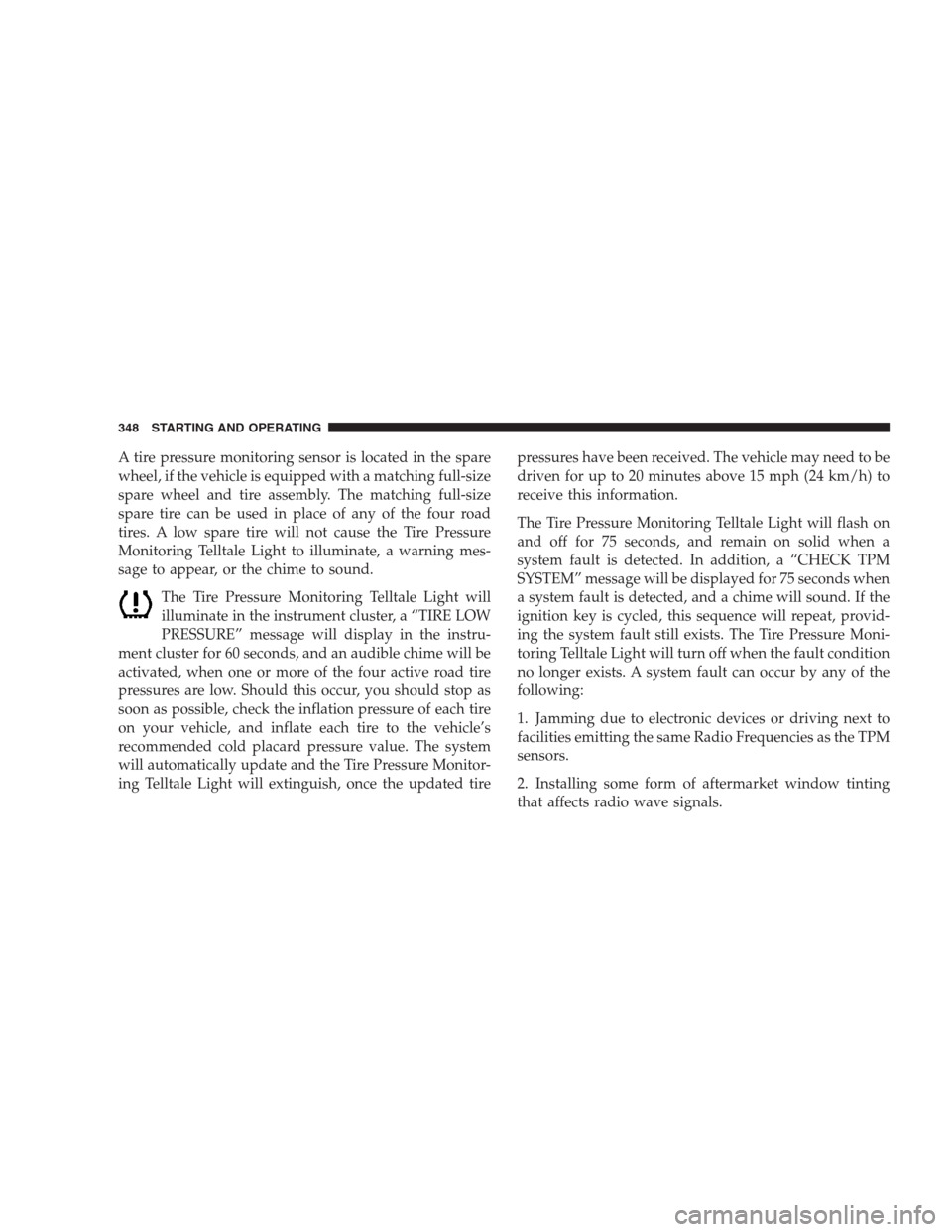
A tire pressure monitoring sensor is located in the spare
wheel, if the vehicle is equipped with a matching full-size
spare wheel and tire assembly. The matching full-size
spare tire can be used in place of any of the four road
tires. A low spare tire will not cause the Tire Pressure
Monitoring Telltale Light to illuminate, a warning mes-
sage to appear, or the chime to sound.
The Tire Pressure Monitoring Telltale Light will
illuminate in the instrument cluster, a “TIRE LOW
PRESSURE” message will display in the instru-
ment cluster for 60 seconds, and an audible chime will be
activated, when one or more of the four active road tire
pressures are low. Should this occur, you should stop as
soon as possible, check the inflation pressure of each tire
on your vehicle, and inflate each tire to the vehicle’s
recommended cold placard pressure value. The system
will automatically update and the Tire Pressure Monitor-
ing Telltale Light will extinguish, once the updated tirepressures have been received. The vehicle may need to be
driven for up to 20 minutes above 15 mph (24 km/h) to
receive this information.
The Tire Pressure Monitoring Telltale Light will flash on
and off for 75 seconds, and remain on solid when a
system fault is detected. In addition, a “CHECK TPM
SYSTEM” message will be displayed for 75 seconds when
a system fault is detected, and a chime will sound. If the
ignition key is cycled, this sequence will repeat, provid-
ing the system fault still exists. The Tire Pressure Moni-
toring Telltale Light will turn off when the fault condition
no longer exists. A system fault can occur by any of the
following:
1. Jamming due to electronic devices or driving next to
facilities emitting the same Radio Frequencies as the TPM
sensors.
2. Installing some form of aftermarket window tinting
that affects radio wave signals.
348 STARTING AND OPERATING
Page 353 of 521
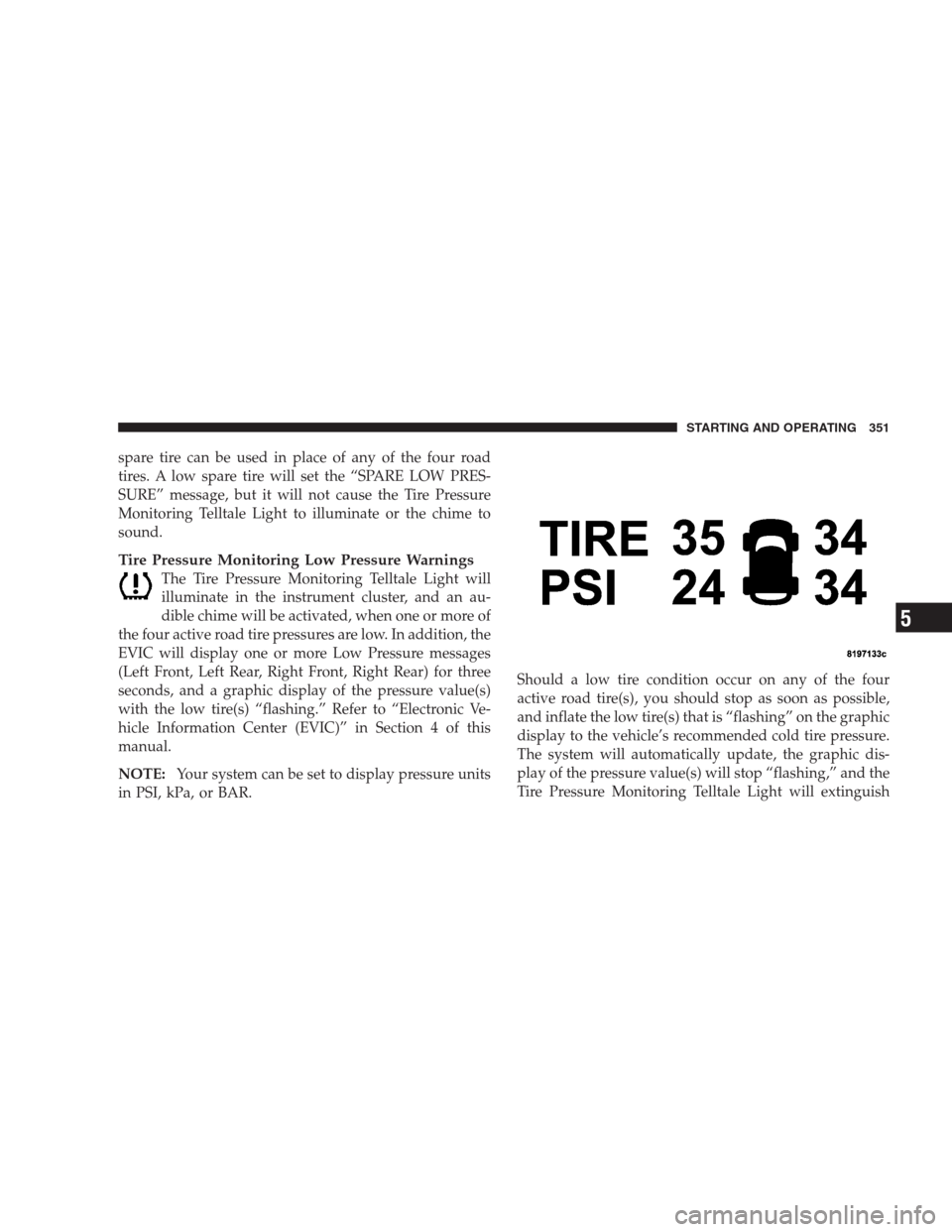
spare tire can be used in place of any of the four road
tires. A low spare tire will set the “SPARE LOW PRES-
SURE” message, but it will not cause the Tire Pressure
Monitoring Telltale Light to illuminate or the chime to
sound.
Tire Pressure Monitoring Low Pressure Warnings
The Tire Pressure Monitoring Telltale Light will
illuminate in the instrument cluster, and an au-
dible chime will be activated, when one or more of
the four active road tire pressures are low. In addition, the
EVIC will display one or more Low Pressure messages
(Left Front, Left Rear, Right Front, Right Rear) for three
seconds, and a graphic display of the pressure value(s)
with the low tire(s) “flashing.” Refer to “Electronic Ve-
hicle Information Center (EVIC)” in Section 4 of this
manual.
NOTE:Your system can be set to display pressure units
in PSI, kPa, or BAR.Should a low tire condition occur on any of the four
active road tire(s), you should stop as soon as possible,
and inflate the low tire(s) that is “flashing” on the graphic
display to the vehicle’s recommended cold tire pressure.
The system will automatically update, the graphic dis-
play of the pressure value(s) will stop “flashing,” and the
Tire Pressure Monitoring Telltale Light will extinguish
STARTING AND OPERATING 351
5
Page 370 of 521
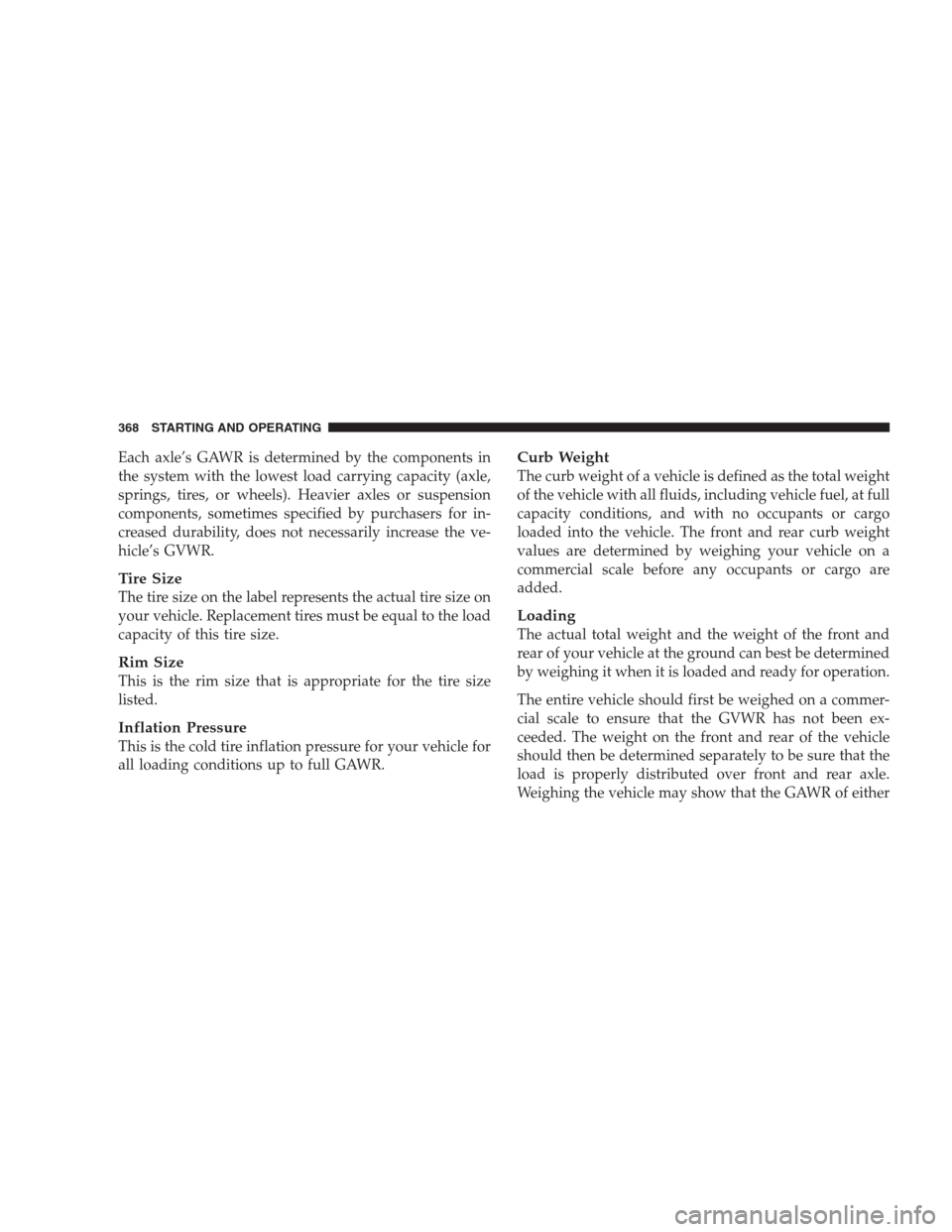
Each axle’s GAWR is determined by the components in
the system with the lowest load carrying capacity (axle,
springs, tires, or wheels). Heavier axles or suspension
components, sometimes specified by purchasers for in-
creased durability, does not necessarily increase the ve-
hicle’s GVWR.
Tire Size
The tire size on the label represents the actual tire size on
your vehicle. Replacement tires must be equal to the load
capacity of this tire size.
Rim Size
This is the rim size that is appropriate for the tire size
listed.
Inflation Pressure
This is the cold tire inflation pressure for your vehicle for
all loading conditions up to full GAWR.
Curb Weight
The curb weight of a vehicle is defined as the total weight
of the vehicle with all fluids, including vehicle fuel, at full
capacity conditions, and with no occupants or cargo
loaded into the vehicle. The front and rear curb weight
values are determined by weighing your vehicle on a
commercial scale before any occupants or cargo are
added.
Loading
The actual total weight and the weight of the front and
rear of your vehicle at the ground can best be determined
by weighing it when it is loaded and ready for operation.
The entire vehicle should first be weighed on a commer-
cial scale to ensure that the GVWR has not been ex-
ceeded. The weight on the front and rear of the vehicle
should then be determined separately to be sure that the
load is properly distributed over front and rear axle.
Weighing the vehicle may show that the GAWR of either
368 STARTING AND OPERATING
Page 380 of 521
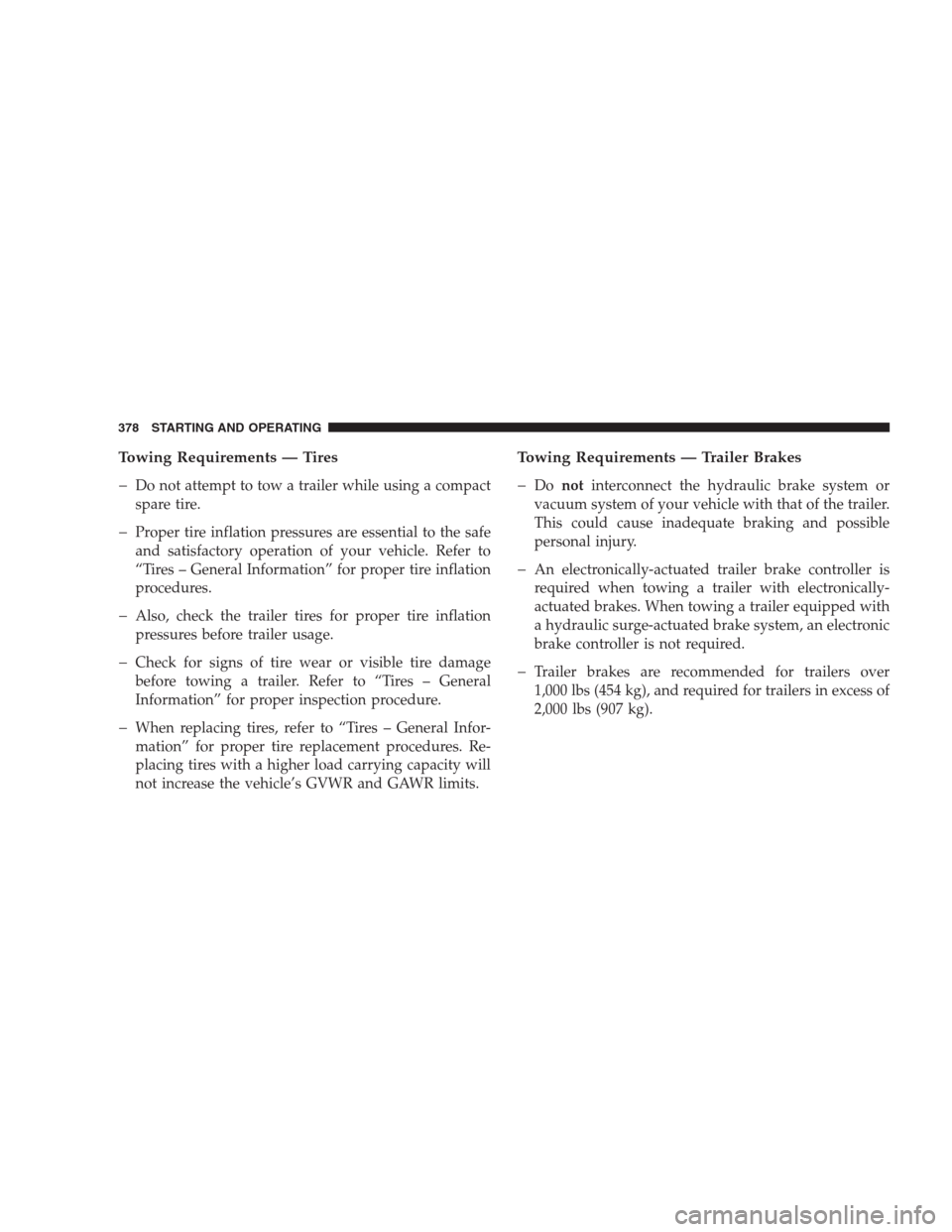
Towing Requirements — Tires
�
Do not attempt to tow a trailer while using a compact
spare tire.
�Proper tire inflation pressures are essential to the safe
and satisfactory operation of your vehicle. Refer to
“Tires – General Information” for proper tire inflation
procedures.
�Also, check the trailer tires for proper tire inflation
pressures before trailer usage.
�Check for signs of tire wear or visible tire damage
before towing a trailer. Refer to “Tires – General
Information” for proper inspection procedure.
�When replacing tires, refer to “Tires – General Infor-
mation” for proper tire replacement procedures. Re-
placing tires with a higher load carrying capacity will
not increase the vehicle’s GVWR and GAWR limits.
Towing Requirements — Trailer Brakes
�
Donotinterconnect the hydraulic brake system or
vacuum system of your vehicle with that of the trailer.
This could cause inadequate braking and possible
personal injury.
�An electronically-actuated trailer brake controller is
required when towing a trailer with electronically-
actuated brakes. When towing a trailer equipped with
a hydraulic surge-actuated brake system, an electronic
brake controller is not required.
�Trailer brakes are recommended for trailers over
1,000 lbs (454 kg), and required for trailers in excess of
2,000 lbs (907 kg).
378 STARTING AND OPERATING
Page 397 of 521
WARNING! (Continued)
•Never start or run the engine with the vehicle on a
jack.
•Do not let anyone sit in the vehicle when it is on a
jack.
•Do not get under the vehicle when it is on a jack.
•Only use the jack in the positions indicated and
for lifting this vehicle during a tire change.
•If working on or near a roadway, be extremely
careful of motor traffic.
•To assure that spare tires, flat or inflated are
securely stowed, spares must be stowed with the
valve stem facing the ground.
•Turn on the Hazard Warning flasher.1. Remove the spare tire, jack, and tools from storage.
2. Loosen (but do not remove) the wheel lug nuts by
turning them to the left, one turn, while the wheel is still
on the ground.
Jack Warning Label
WHAT TO DO IN EMERGENCIES 395
6
Page 498 of 521
Vehicle Safety Standard No. 109. Grades B and A repre-
sent higher levels of performance on the laboratory test
wheel, than the minimum required by law.
WARNING!
The temperature grade for this tire is established for
a tire that is properly inflated and not overloaded.
Excessive speed, under-inflation, or excessive load-
ing, either separately or in combination, can cause
heat buildup and possible tire failure.
496 IF YOU NEED CONSUMER ASSISTANCE
Page 502 of 521
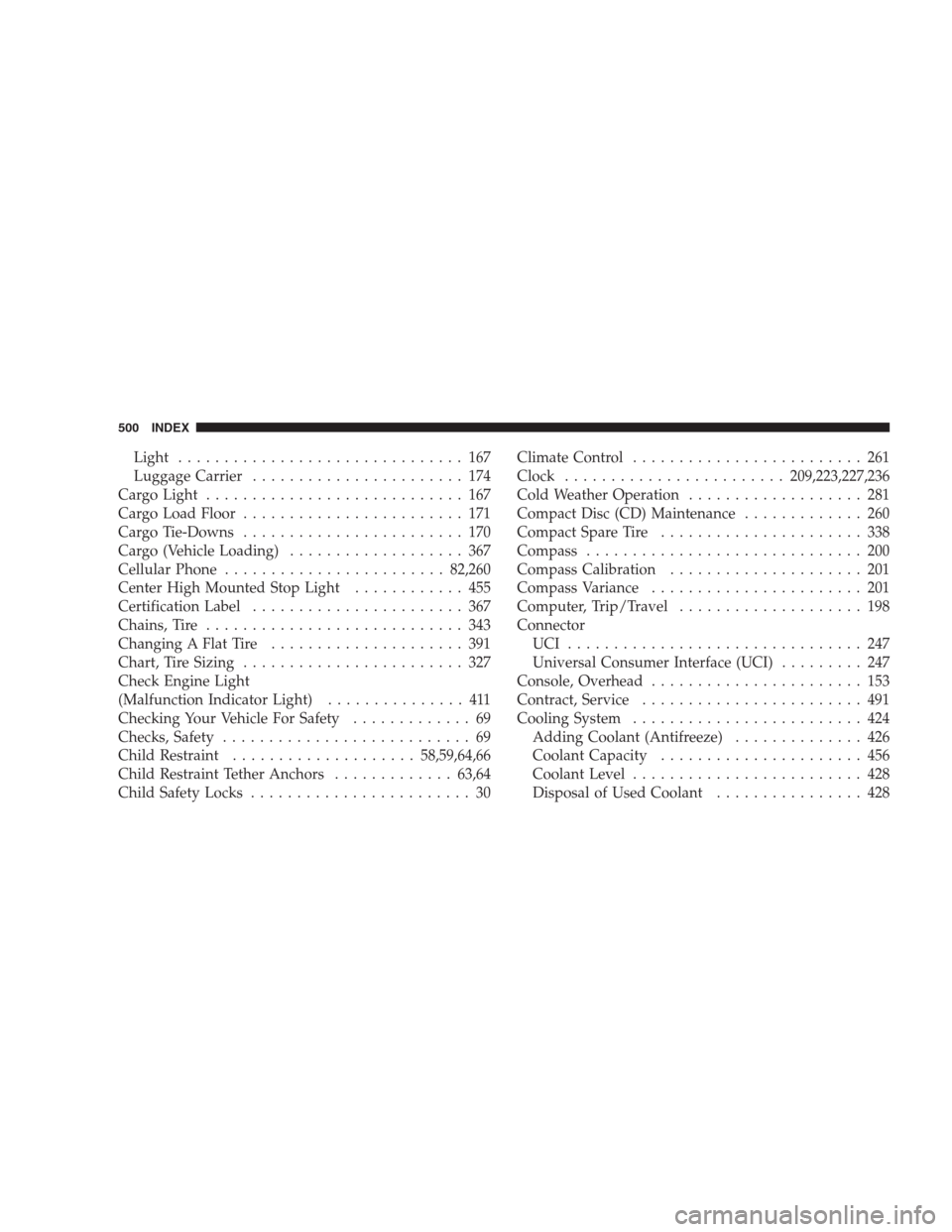
Light............................... 167
Luggage Carrier....................... 174
Cargo Light............................ 167
Cargo Load Floor........................ 171
Cargo Tie-Downs........................ 170
Cargo (Vehicle Loading)................... 367
Cellular Phone........................82,260
Center High Mounted Stop Light............ 455
Certification Label....................... 367
Chains, Tire............................ 343
Changing A Flat Tire..................... 391
Chart, Tire Sizing........................ 327
Check Engine Light
(Malfunction Indicator Light)............... 411
Checking Your Vehicle For Safety............. 69
Checks, Safety........................... 69
Child Restraint....................58,59,64,66
Child Restraint Tether Anchors.............63,64
Child Safety Locks........................ 30Climate Control......................... 261
Clock........................209,223,227,236
Cold Weather Operation................... 281
Compact Disc (CD) Maintenance............. 260
Compact Spare Tire...................... 338
Compass.............................. 200
Compass Calibration..................... 201
Compass Variance....................... 201
Computer, Trip/Travel.................... 198
Connector
UCI ................................ 247
Universal Consumer Interface (UCI)......... 247
Console, Overhead....................... 153
Contract, Service........................ 491
Cooling System......................... 424
Adding Coolant (Antifreeze).............. 426
Coolant Capacity...................... 456
Coolant Level......................... 428
Disposal of Used Coolant................ 428
500 INDEX
Page 507 of 521
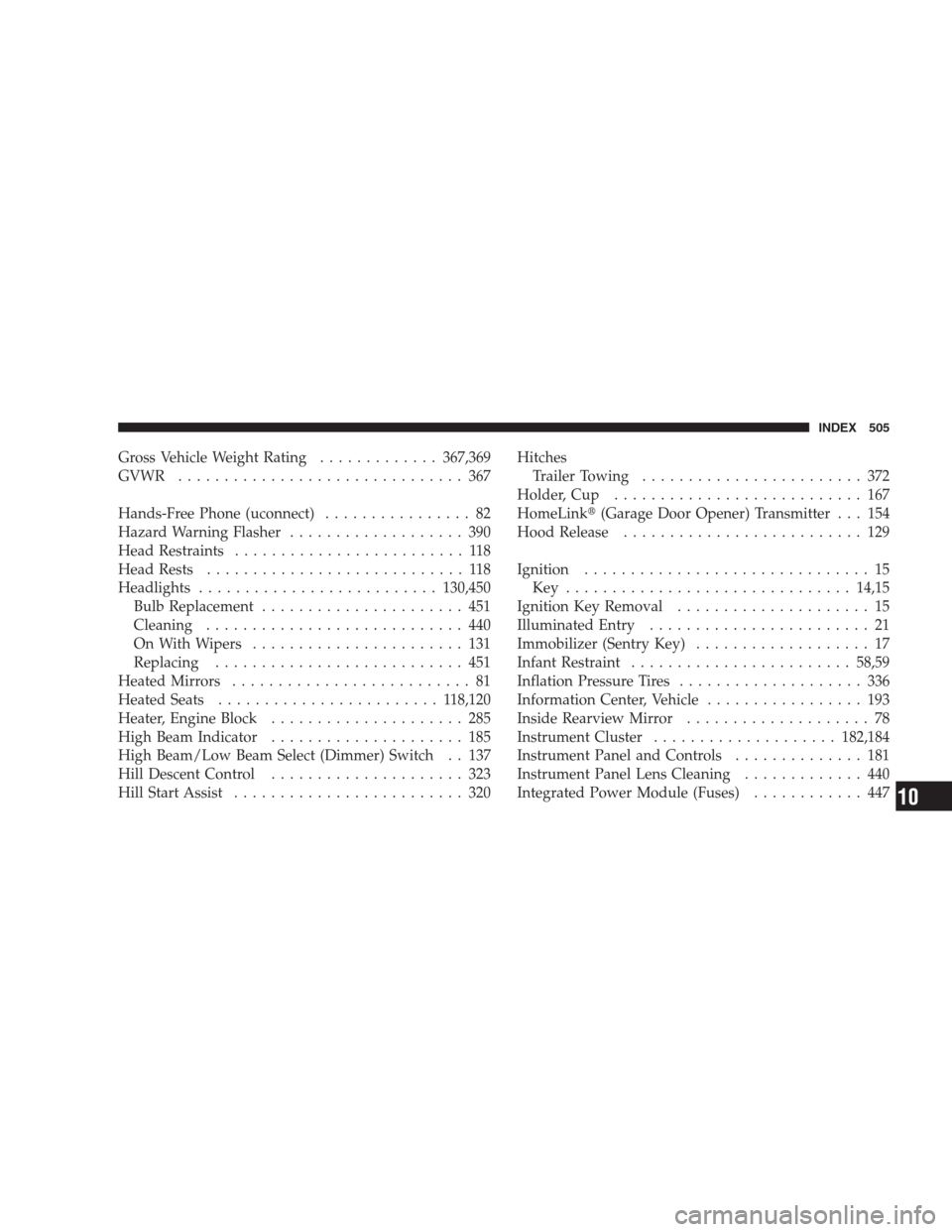
Gross Vehicle Weight Rating.............367,369
GVWR............................... 367
Hands-Free Phone (uconnect)................ 82
Hazard Warning Flasher................... 390
Head Restraints......................... 118
Head Rests............................ 118
Headlights..........................130,450
Bulb Replacement...................... 451
Cleaning............................ 440
On With Wipers....................... 131
Replacing........................... 451
Heated Mirrors.......................... 81
Heated Seats........................ 118,120
Heater, Engine Block..................... 285
High Beam Indicator..................... 185
High Beam/Low Beam Select (Dimmer) Switch . . 137
Hill Descent Control..................... 323
Hill Start Assist......................... 320Hitches
Trailer Towing........................ 372
Holder, Cup........................... 167
HomeLink�(Garage Door Opener) Transmitter . . . 154
Hood Release.......................... 129
Ignition............................... 15
Key ...............................14,15
Ignition Key Removal..................... 15
Illuminated Entry........................ 21
Immobilizer (Sentry Key)................... 17
Infant Restraint........................58,59
Inflation Pressure Tires.................... 336
Information Center, Vehicle................. 193
Inside Rearview Mirror.................... 78
Instrument Cluster....................182,184
Instrument Panel and Controls.............. 181
Instrument Panel Lens Cleaning............. 440
Integrated Power Module (Fuses)............ 447
INDEX 505
10